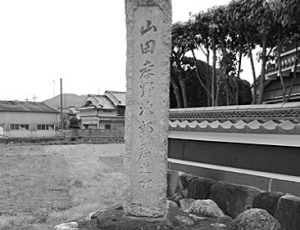Monument of YAMADA Konojiro
 YAMADA Konojiro was born in Kashihara Kitaho on 25 February 1906. Being
physically small because of gdwarfismh, caused by a deficiency of growth
hormones, the doctor stated that he would not be able to reach his majority
alive.
YAMADA Konojiro was born in Kashihara Kitaho on 25 February 1906. Being
physically small because of gdwarfismh, caused by a deficiency of growth
hormones, the doctor stated that he would not be able to reach his majority
alive.Having made his dashing appearance at the Founding Congress of the Zenkoku Suiheisha, he criticized officials and teachers, stating, gWhat cold eyes do teachers have on the platform?h, and elaborated on the reality of contempt and exclusion in tears. When he heard sobs from the audience, he scolded them, saying, gItfs not a time for us to cry. Adults and children should stand up in unison to beat the causes of this grief. Make a brilliant new societyh, to which the audience responded with a thunder of applause. Since then, YAMADA bustled about all over the country for creating the Suiheisha at different places, being highly evaluated for his skills in public speaking. He proposed the creation of the Zenkoku Suiheisha of Boys and Girls, which would gdenounce diabolic education thoroughlyh, at the second national congress of the Zenkoku Suiheisha. The proposal was approved at the fourth national congress, which made the organization one of the highest organ of the Zenkoku Suiheisha. He was also a right-hand man of MATSUMOTO Jiichiro and ran about all over the country, although he lived in Fukuoka.
He died of illness at the home of TAKAOKA Minoru (Kanehira, Fukuoka City) on 9 March 1931. On 18 March, one week after the comrade funeral undertaken by the Kyushu Suiheisha, the funeral sponsored by the Zenkoku Suiheisha was conducted at the Saikoji in his hometown Kashihara.
The Wakigami Village Office used to stand on the site in front of the monument; to the west of the site stood the Wakigami Ordinary Elementary School (current Wakigami Elementary School) that YAMADA had attended in his childhood.
The letters gMonument of Mr. YAMADA Konojiroh are inscribed on the face of the monument and on the back, gDied on 9 March 1931; Erected by the Zenkoku Suiheisha in September 1936h.
[Back]
[Home]